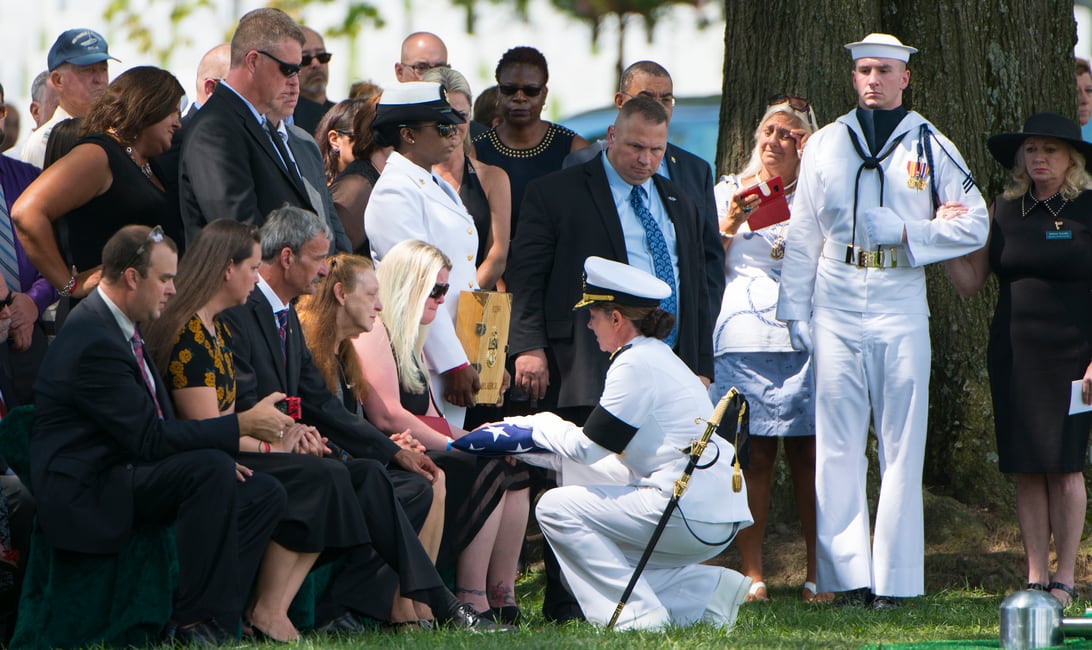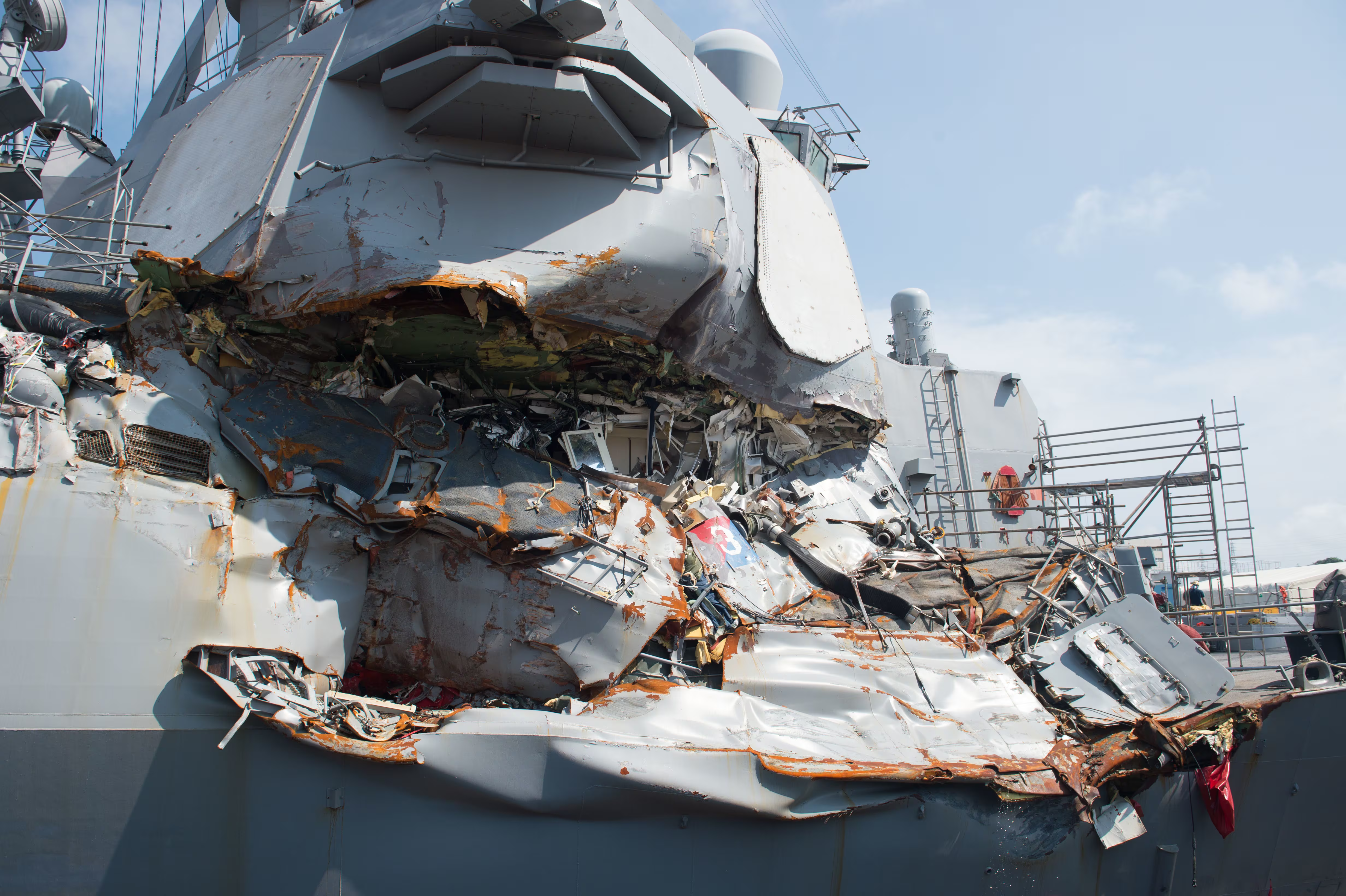In a surprise move during a Tuesday hearing in a Washington Navy Yard courtroom, defense attorneys representing Lt. Natalie Combs held up a new piece of evidence that might exonerate her at her upcoming court-martial trial.
It’s a photograph — a still image captured from digital footage recorded by an aft Vertical Launching System camera mounted on the guided-missile destroyer Fitzgerald on June 17, 2017, seconds after it was speared and spun off the coast of Japan by the hulking ACX Crystal, a Philippine-flagged cargo vessel.
What it reveals is something that hasn’t surfaced in any of the Navy’s publicly-released probes or even a secret military “dual-purpose” investigation obtained by Navy Times and completed 41 days after the tragedy.
It shows a string of lights on the ACX Crystal that Coast Guard Lt. Cmdr. Jeff Janaro — an attorney who also commanded vessels at sea — called an “improper lighting configuration,” one that appeared to the defense team to be “recklessly unlawful.”
That’s important because if the ACX Crystal’s lamps were positioned incorrectly, that alignment might’ve fooled the watchstanders on the Fitz’s bridge who were trying to track multiple vessels in one of the world’s busiest maritime superhighways, piecing together a picture of the night through radar readings and visual clues.
Ship travel is governed by the “rules of the road,” a set of guidelines regarding speed, lookouts and other best practices to avoid collisions. Those bylaws include how lights are configured on ships.
The green lights on the side of a vessel should be visible from three miles away, six miles for the bright white lights running from bow to stern.
“This picture tells us it didn’t look right,” Janaro told Navy judge Cmdr. Arthur Gaston. “We think the Crystal was very negligent in this matter.”
Few people have seen the image — maybe only a handful of attorneys in Washington, Lt. Combs and Navy Times — but it “might be worth a thousand words,” as Gaston put it.
It’s unclear if even the Coast Guard investigators working on a National Transportation Safety Board probe into the Fitzgerald collision have a copy of it.
RELATED

On the night of the collision, Combs never would’ve seen the lights of the ACX Crystal with her own eyes. She was in charge of the Fitz’s electronic nerve center below the bridge, what’s called the Combat Information Center, or "CIC.'
Her team was supposed to use advanced sensors like the Arleigh Burke-class destroyer’s SPS-67 radar to track vessels near the Fitz and relay what they detected to the watchstanders on the bridge.
But the secret probe helmed by Rear Adm. Brian Fort determined that Combs' CIC had "zero communication” with the bridge team before the Crystal loomed seemingly out of nowhere to ram the Fitz’s starboard hull.
Although listed as operational, the CIC’s SPS-67 system actually had fallen into a “degraded status,” according to Fort’s report. Some CIC sailors didn’t appear to know how to use the equipment — much of it in various states of disrepair — and the room itself was heaped in garbage, human waste and exercise equipment.
In the aftermath of the ACX Crystal collision, Fort found a stack of abandoned forms where Combs had been sitting.
“She was most likely consumed and distracted by a review of Operations Department paperwork for the three and a half hours of her watch prior to the collision,” he wrote.
Fort determined that Combs was derelict in her CIC duties, but an investigating officer assigned to her initial Article 32 hearing, Cmdr. Anthony Johnson, sifted through the same evidence and recommended that she skip court-martial proceedings and go instead to a Navy board of inquiry to determine if she should remain on duty.
Adm. James Caldwell, the convening authority in her case, disregarded Johnson and charged Combs with dereliction of duty that negligently resulted in the death of fellow sailors and the negligent and improper hazarding of a vessel.
RELATED

To Janaro and star military defense attorney David Sheldon, the photo casts into doubt the first charge.
It relies on a “but for” clause — but for Combs' derelict leadership, the mishap would not have occurred. They believe that the ACX Crystal shouldered much of the blame for the accident, and bad Navy practices set her up to fail.
They pointed to the recent settlement between the U.S. Department of Justice and Olympic Steamship Company, S.A., Panama, the owners of the ACX Crystal.
They’re forking over $26.7 million to the United States.
While finding plenty of fault with Combs and other Americans on the Fitzgerald for the collision, Fort’s report also takes aim at the crew of the ACX Crystal, in particular an unnamed second officer.
Among a long list of failures listed in the Fort report, that officer “failed to maintain a proper lookout so as to make a full appraisal of the risk of collision” with the Fitzgerald, "failed to determine if a risk of collision with FTZ existed by using all available means” and “he failed to appreciate, by radar or visual observation, that FTZ was on a constant bearing with a decreasing range, which observation would have led him to deem risk of collision to exist.”
Sheldon and Janaro want to interview two Filipino officers from the ACX Crystal about their vessel’s lights captured in the photo, plus the many other problems raised in Fort’s report.
The attorneys have a series of transcripts from previous interviews the officers did, but their words are marked “indiscernible” 203 times.
The defense team thinks their testimony might free Combs.
Military prosecutor Lt. Cmdr. Kate Shovlin told Gaston that Naval Criminal Investigative Service made a good faith effort to talk to the men, but they avoided the agent who visited their homes and workplace.
Their family members also told NCIS the ACX Crystal crewmen wouldn’t cooperate with American investigators.
Combs' defense team wants to trigger a treaty between Washington and Manila that would prod authorities in the Philippines to compel the ACX Crystal’s officers to testify, but that threatens to push the court-martial trial well past its slated late May opening.
That’s also around the time the highly-anticipated NTSB probe is expected to be released.
Prine came to Navy Times after stints at the San Diego Union-Tribune and Pittsburgh Tribune-Review. He served in the Marine Corps and the Pennsylvania Army National Guard. His awards include the Joseph Galloway Award for Distinguished Reporting on the military, a first prize from Investigative Reporters & Editors and the Combat Infantryman Badge.




